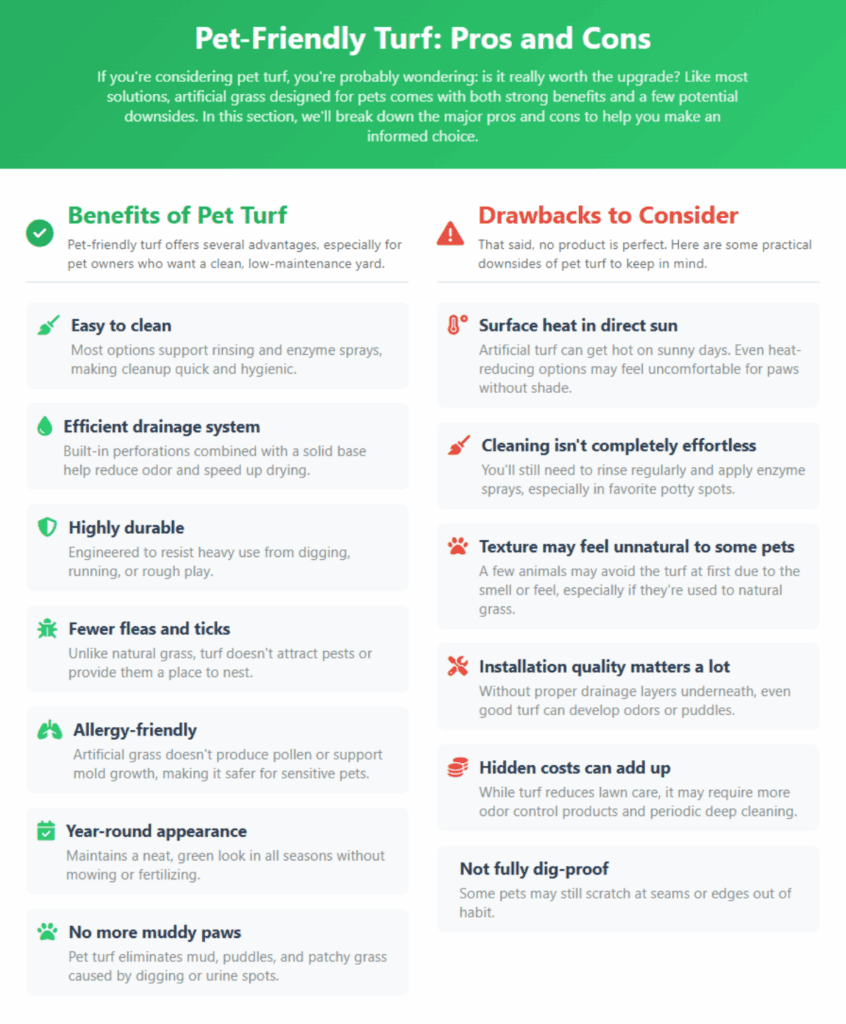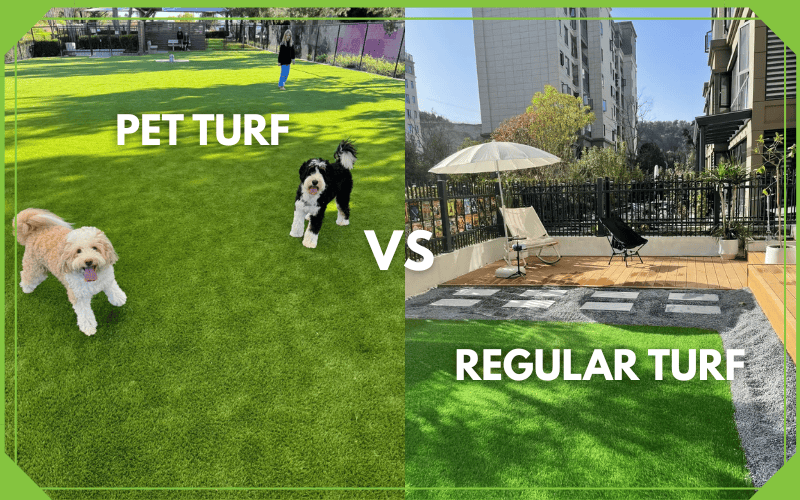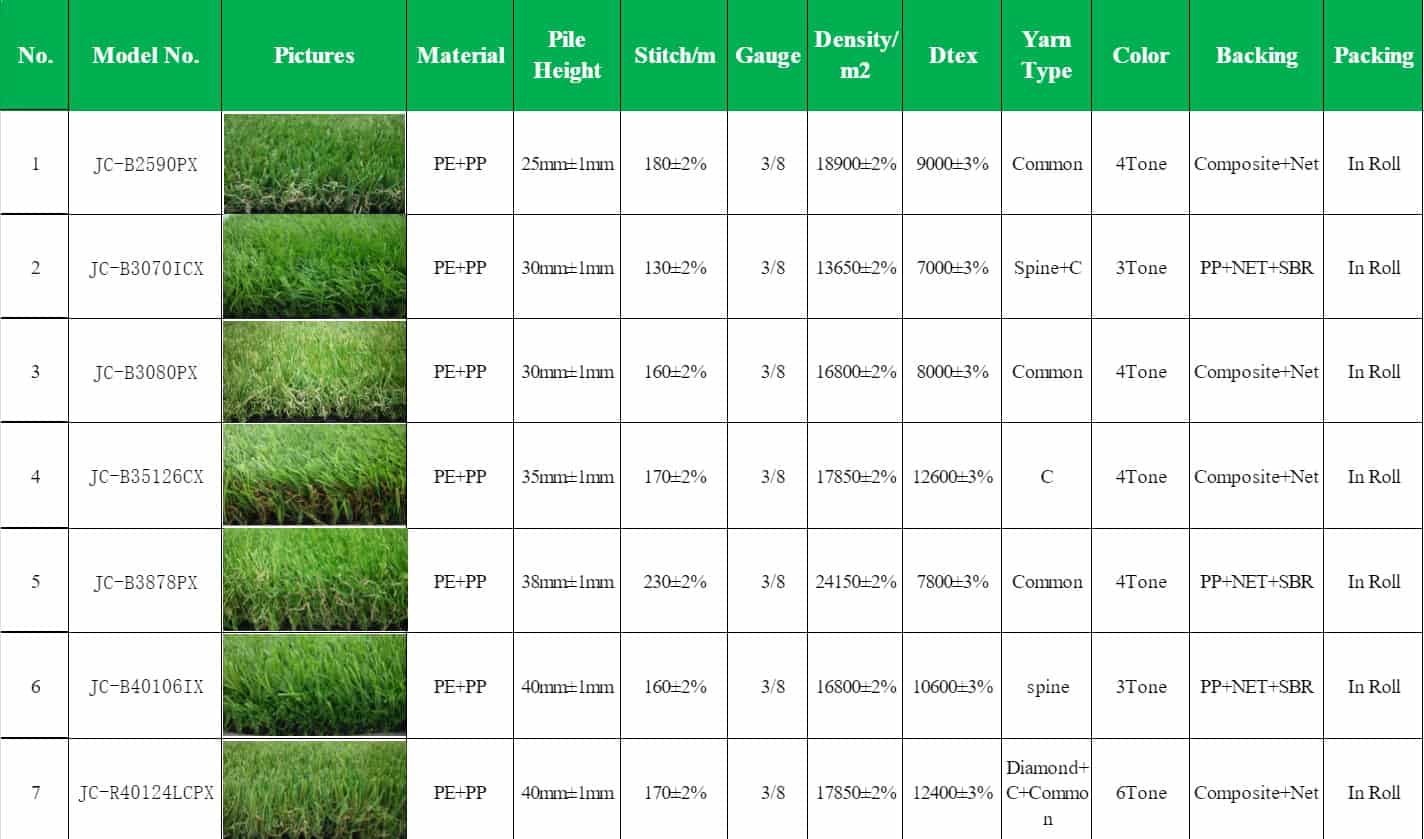Thinking about using artificial turf for your pets? You’re not alone—but not all turf is the same, and the wrong choice can lead to odors, damage, or discomfort. Many people assume regular turf works just fine for pets—until they run into issues that pet-specific turf is designed to solve.
In this article, we’ll break down the key differences between pet turf and regular turf across five essential categories: material durability, drainage and odor control, ease of cleaning, pet safety and comfort, and long-term value. We’ll also cover the pros and cons of pet turf, when it’s worth the upgrade, the risks of using regular turf for pets, and common misconceptions that often mislead buyers.
By the end, you’ll know exactly what makes pet turf different—and whether it’s the right fit for your home and your pet.
Key Differences Between Pet Turf and Regular Turf
Choosing between pet turf and regular turf can be tricky—especially if you’re not sure what actually sets them apart. While both are types of artificial grass, they’re made for very different needs. In this section, we’ll compare them across five key areas: durability, drainage, ease of cleaning, pet safety, and long-term cost.
napkin图/
Material Composition and Durability
Pet turf is designed for strength. Its blades are thicker, stitched more densely, and the backing is often double-layered. This makes it better at handling scratching, digging, and chewing. Many pet turf products are also UV-stabilized, so they won’t fade or weaken under the sun. Regular turf, on the other hand, is usually built for looks or sports use. It might feel soft, but it’s less durable under everyday pet activity.
Drainage and Odor Control
Good drainage is essential when pets urinate outside. Pet turf includes perforated backing or permeable base layers that help liquids pass through quickly. This reduces odor and prevents bacteria buildup. But drainage isn’t just about the turf—it’s also about what’s underneath. A proper pet turf system includes a compacted aggregate base that works with the turf layer to keep things clean. Most regular turf lacks this design and can trap moisture, leading to lingering smells.
Maintenance and Cleaning Requirements
Pet turf is made with cleanup in mind. You can easily rinse it with water, pick up solid waste, and apply pet-safe enzyme sprays to control odors. Many products clearly state their compatibility with enzyme-based cleaners. Regular turf may not clean as easily. It tends to trap fur and debris, and odor may stick around unless you scrub it more aggressively. Choosing a turf designed for easy cleaning can save you time and frustration.
Safety and Comfort for Pets
Pet turf is built for paws. It’s usually free from lead, heavy metals, and other harmful chemicals. Many versions also use heat-reducing materials to keep surface temperatures lower in hot weather. Even though the fibers are denser, they’re engineered to feel soft and springy underfoot. In contrast, regular turf can get uncomfortably hot and might contain infills not ideal for animals. Not all turf is pet-safe—check product specs if you’re unsure.
Cost and Long-Term Value
Pet turf typically costs more to install. But that higher upfront investment often pays off. It lasts longer, resists damage, and reduces the need for odor treatments or turf replacement. Regular turf might seem like a budget-friendly option, but frequent cleaning, early wear, or pet damage can drive up long-term costs. Some premium landscape turfs can handle pets decently, but they usually lack the built-in features that make true pet turf worth it.
| Aspect | Pet Turf | Regular Turf |
| Durability | Reinforced fibers; resists digging, scratching, and chewing | Softer blades; not built for heavy pet activity |
| Drainage & Odor Control | Perforated backing + proper base system for fast drainage and odor control | Often lacks drainage; prone to puddles and smell buildup |
| Ease of Cleaning | Compatible with enzyme sprays; easy to rinse and maintain | Traps fur and odor; deeper cleaning needed |
| Pet Safety & Comfort | Non-toxic materials, cooler surface, paw-friendly density | May contain infills; can overheat and irritate paws |
| Cost & Value | Higher upfront cost; more durable and low-maintenance over time | Lower initial cost; may require more frequent repairs and odor treatment |
Pros and Cons of Pet-Friendly Turf
If you’re considering pet turf, you’re probably wondering: is it really worth the upgrade? Like most solutions, artificial grass designed for pets comes with both strong benefits and a few potential downsides. In this section, we’ll break down the major pros and cons to help you make an informed choice.

Benefits of Pet Turf
Pet-friendly turf offers several advantages, especially for pet owners who want a clean, low-maintenance yard:
- Easy to clean: Most options support rinsing and enzyme sprays, making cleanup quick and hygienic.
- Efficient drainage system: Built-in perforations combined with a solid base help reduce odor and speed up drying.
- Highly durable: Engineered to resist heavy use from digging, running, or rough play.
- Fewer fleas and ticks: Unlike natural grass, turf doesn’t attract pests or provide them a place to nest.
- Allergy-friendly: Artificial grass doesn’t produce pollen or support mold growth, making it safer for sensitive pets.
- Year-round appearance: Maintains a neat, green look in all seasons without mowing or fertilizing.
- No more muddy paws: Pet turf eliminates mud, puddles, and patchy grass caused by digging or urine spots.
If you’re tired of patchy grass and daily yard upkeep, pet turf can offer a major lifestyle upgrade.
Drawbacks to Consider
That said, no product is perfect. Here are some practical downsides of pet turf to keep in mind:
- Surface heat in direct sun: Artificial turf can get hot on sunny days. Even heat-reducing options may feel uncomfortable for paws without shade.
- Cleaning isn’t completely effortless: You’ll still need to rinse regularly and apply enzyme sprays, especially in favorite potty spots.
- Texture may feel unnatural to some pets: A few animals may avoid the turf at first due to the smell or feel, especially if they’re used to natural grass.
- Installation quality matters a lot: Without proper drainage layers underneath, even good turf can develop odors or puddles.
- Hidden costs can add up: While turf reduces lawn care, it may require more odor control products and periodic deep cleaning.
- Not fully dig-proof: Some pets may still scratch at seams or edges out of habit.
Pet turf works best when properly installed and regularly maintained. If that fits your lifestyle and your pet’s habits, it’s a smart and lasting improvement.
When Should You Choose Pet Turf Over Regular Turf?
Pet turf and regular artificial turf may look similar, but they serve different needs. If your situation matches any of the following, pet turf is likely the better choice.
- Your dog urinates on the turf often. Regular turf isn’t built to handle frequent urination—it can trap moisture and cause odors. Pet turf drains faster and is easier to sanitize.
- Odor has become an ongoing problem. If you’ve tried deodorizing your turf but smells still linger, upgrading to pet-specific turf can make a noticeable difference.
- You’ve experienced turf damage from digging or chewing. Pet turf is made with denser blades and tougher backing to resist damage. Standard turf wears out faster under stress.
- You want a turf system that lasts longer with pets. Pet turf may cost more upfront, but it’s built to withstand heavy, repeated use—making it more cost-effective over time.
- You’re planning to install turf specifically for a pet zone. Starting with the right product helps avoid costly replacements later. Pet turf is designed for consistent, hygienic use.
If you’ve run into any of these problems—or want to avoid them altogether—pet turf offers a targeted solution that regular turf can’t match.
Can You Use Regular Turf for Pets? What Are the Risks?
Yes, you can use regular artificial turf for pets—but it’s not recommended for daily use due to several design limitations and long-term risks. Standard turf isn’t made for animals, and using it for dogs or cats often leads to recurring problems.
The biggest issue is drainage. Most general-use turf doesn’t drain fast enough, especially if your dog uses the same spot. Urine gets trapped under the surface, causing stubborn odors and bacterial buildup. Over time, this can irritate your pet’s paws—and once the smell sets in, even professional cleaners may not fix it.
Cleaning is harder, too. Without antimicrobial protection, odor sinks deep into the turf backing. Some pet owners end up replacing entire sections—not because the turf wore out, but because the smell became unbearable.
Safety is another concern. Standard turf can get hot in the sun and may include infills that aren’t pet-safe. What feels like a cost-saving choice now could turn into a long-term hassle.
For light use, regular turf might hold up. But for daily pet traffic, skipping pet turf is a shortcut you’ll likely regret.
Common Misconceptions About Pet Turf
Even with the facts laid out, some doubts still linger. Let’s address the most common myths head-on—so you can make a fully informed decision.
Pet turf has come a long way in design and technology, but a few common myths still keep some pet owners from giving it a fair shot. Let’s clear up the most frequent misunderstandings:
- “Pet turf looks too fake.”
Modern pet turf uses multi-tone blades and realistic thatch, making it almost indistinguishable from real grass at a glance. - “It’s harder to clean than real grass.”
Actually, the opposite is true. Pet turf drains quickly and works with enzyme sprays, making cleanup easier and more consistent than on soil or natural turf. - “Pets won’t like it or won’t use it.”
Most pets adapt quickly. The surface stays dry, soft, and paw-friendly. Some initial hesitation is normal but rarely lasts. - “All turf is the same—pet turf is just a marketing gimmick.”
Pet turf is purpose-built with features like extra drainage, antimicrobial backing, and better durability. It’s not just a label—it’s a functional upgrade.
Clearing up these myths can help you make a more confident, informed choice about what’s best for your yard and your pet.
Final Thoughts: Which Turf Is Right for You and Your Pet?
At this point, the choice between pet turf and standard artificial turf comes down to what your yard—and your pet—really need. If you’re looking for better drainage, easier cleanup, fewer odors, and a paw-safe surface built to last, pet turf clearly stands out.
That doesn’t mean regular turf has no place. For light use or non-potty zones, it might be enough. But if your pet uses the space every day, a turf built specifically for that purpose will save you more time, stress, and money over the long run.
Think about how your pet interacts with your yard. Then choose the turf that matches—not just today, but for years to come.
Real Pet Turf. No Guesswork.
Most turf brands claim to be pet-friendly. We actually engineer for it.
Biyuan’s pet turf features precision-perforated backing for faster drainage, an odor-neutralizing antimicrobial layer, and UV-resistant PE fibers tested for paw traffic and weather exposure. It’s designed to stay clean, safe, and durable—day after day, season after season.
Whether you’re upgrading from regular turf or choosing for the first time, start with turf that’s made for pets—not just labeled for them.
Ask for a free sample or quote. You’ll know the difference the moment it’s down.


